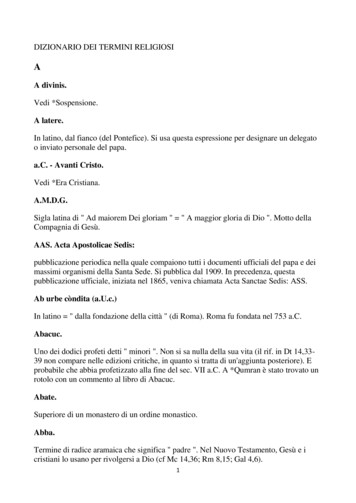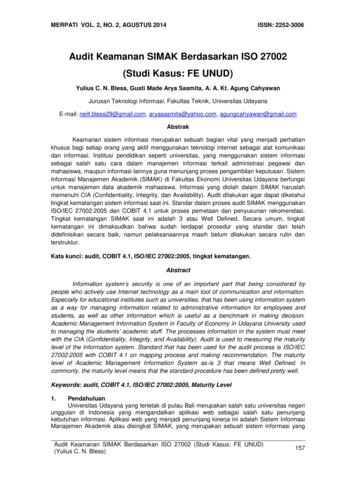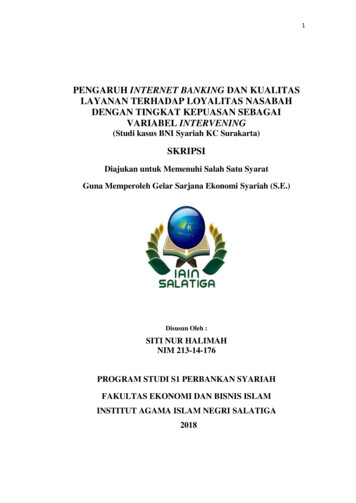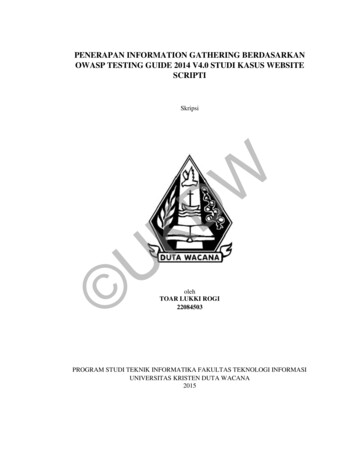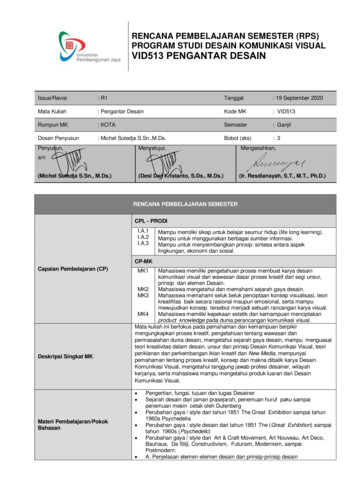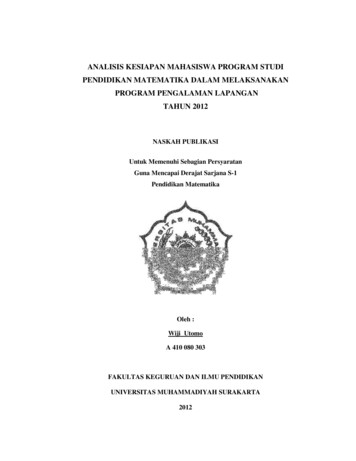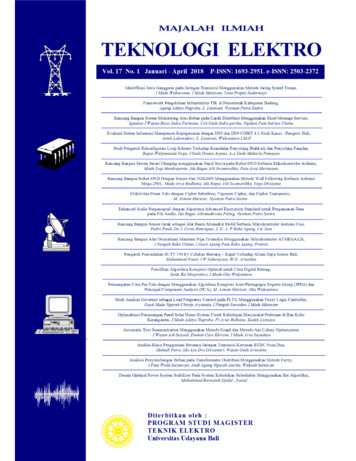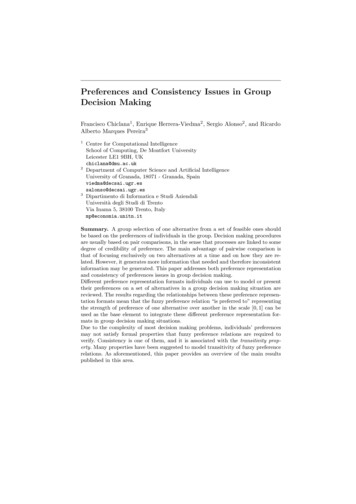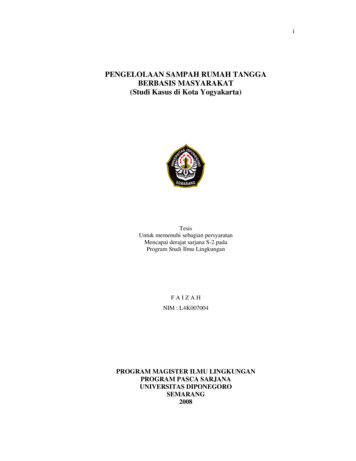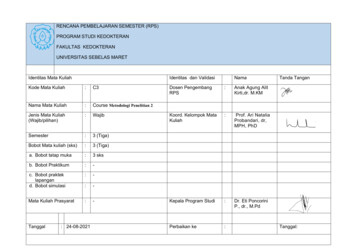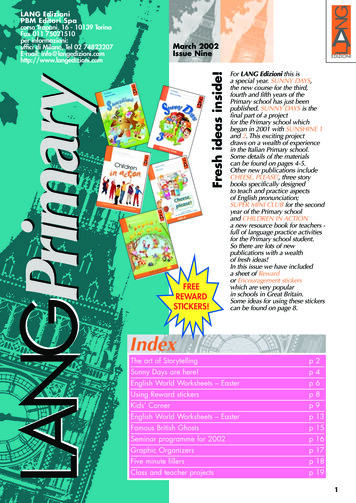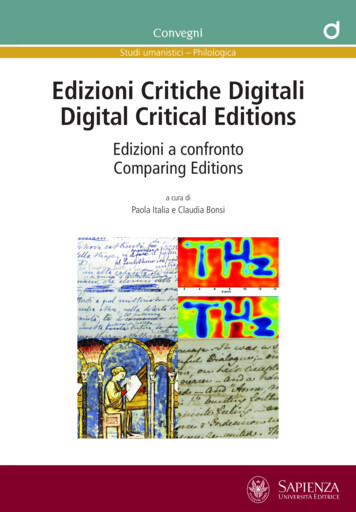
Transcription
ConvegniStudi umanistici – PhilologicaEdizioni Critiche DigitaliDigital Critical EditionsEdizioni a confrontoComparing Editionsa cura diPaola Italia e Claudia Bonsi
Edizioni Critiche DigitaliDigital Critical EditionsEdizioni a confrontoComparing Editionsa cura diPaola Italia e Claudia Bonsi2016
Il volume è stato realizzato con i Fondi del Progetto Multidisciplinare THESMASapienza Ricerca 2014 svolto in collaborazione tra il Dipartimento di Studi GrecoLatini, Italiani, Scenico-Musicali e il Dipartimento di Fisica.Copyright 2016Sapienza Università EditricePiazzale Aldo Moro 5 – 00185 ma1.itIscrizione Registro Operatori Comunicazione n. 11420ISBN 978-88-9377-003-3Pubblicato a dicembre 2016Quest’opera è distribuita con licenza Creative Commons 3.0diffusa in modalità open access.Realizzazione editoriale a cura di Antonio D’Ambrosio.In copertina: elaborazione grafica a cura di Maria Villano. In alto a sinistra: particolare dellap. 309 del manoscritto di Eros e Priapo di Carlo Emilio Gadda, per gentile concessione degli eredi.In basso a destra: Jane Austen’s Pride and Prejudice, p. 1, c. 10 The British Library Board.
2. Fernando Pessoa’s Book of Disquietas a Dynamic Digital ArchiveManuel Portela, António Rito SilvaLdoD Archive is a dynamic digital archive based on Fernando Pessoa’s Livro do Desassossego [“L. do D.”] http://ldod.uc.pt. The Archivecontains facsimiles and textual transcriptions of autograph witnesses(manuscripts, typescripts, printed texts) as well as textual transcriptions of four editions of the Book of Disquiet published between 1982and 2012. All variations across the textual corpus have been marked upin TEI-conformant XML. This granular encoding has enabled us to automate comparisons between any 2, 3, 4 or 5 versions of any given fragment, both at the micro-scale of textual form, and at the macro-scaleof bibliographic structure. Besides the set of functionalities related tothe scholarly level of the archive, the LdoD Archive provides a set ofsoftware tools that allow readers to generate further content by creating their own editions and annotations within the archive’s virtuallayer, and by writing their own variations based on specific passages. The research for this project culminated in a dynamic model for adigital archive, which brings collaborative computing techniques intothe universe of critical editing and reading in digital media. This article discusses the conceptual and technical virtualization of the Book ofDisquiet as a digital simulation of the dynamic nature of textual fields,and presents the project’s workflow from expert encoding to end-userinteraction.2.1. From Textual Marks to Textual Fields: A Dynamicand Socialized ArchiveGenerally speaking, critical digital editions follow remediationprocesses that correspond to a medial transfer centered on a mimetic
24Edizioni Critiche Digitali - Digital Critical Editionsrelationship with the original documents, including digital reconstruction of their handwritten, typescript, or printed modularity. Thus, thereconstitution of the autograph archive and its editions follows a representational principle, whose aim is to authenticate its own authority as both facsimile image and textual transcription of the document,supplemented by a comprehensive critical apparatus that explainsautographic inscriptions and their editorial transformations. The interpretative nature of the editorial act is minimized, through a transparency effect obtained by the facsimile presence of the object, throughexhaustive description in metadata and notes, and also through textual encoding for automatic processing. This principle of representational completeness manifests itself in the content and structure of thedifferent modules of the Text Encoding Initiative, whose hierarchicaltagging system contains extremely granular descriptions of a hugeamount of textual forms and events.Although deeply aware of the remedial specificity of digital media,research carried out in the field of digital critical editing has focusedon the transfer and expansion of the critical edition model into digital space and has been less concerned with the reconceptualizationof the relationship between document and transcript, or between textand critical apparatus [Shillingsburg 2006 and 2009; Roland 2011;Kirschenbaum 2013; Robinson 2013; Apollon et al. 2014; Pierazzo2015]. The strong mimetic power of digital visual representation haslimited the experimentation with other possibilities for modeling textual objects. In our view, both intentionalist editing models, and socialediting models, remain dominated by a representational descriptivelogic and a comprehensive emulation of the document. The possibility of facsimile representation of the original in high-resolution andthe consequent mapping of textual marks by means of topographicaltranscriptions – made according to a granular system of spatial coordinates – testifies to this fetishism and monumentalization of the object.The principle of exhaustiveness in description contains an ingraineddesire for transparency and coincidence between transcription and inscription, as if transcription or facsimile representation could evade theprocess of abstraction and modeling of its textual object [Roland 2011].Three recent digital editions in which the mimetic logic in the representation of marks is expressed through a spatial mapping of writing marks according to a topographic coordinate system are SamuelBeckett Digital Manuscript Project (2011-2016), the prototype for Mar-
2. Fernando Pessoa’s Book of Disquiet as a Dynamic Digital Archive25cel Proust’s Cahier 46 (2013) and Woolf Online (2011-2016).1 In 2011,an encoding model for genetic editions was integrated into the TEIguidelines, introducing new sets of tags for topographic encoding ofdocuments (e.g. surface and zone ) which encouraged editors tointensify this emulation component in their transcripts.2 The justification for the TEI encoding prototype of Proust’s Cahier 46 (which usesthe new spatial tags to rehearse a timelime of composition) underlinesthe gain in representing the dynamics of writing as a gain of mimeticfidelity:Les éditions ultra-diplomatiques en ligne sont en général présentées en visà-vis du fac-similé du manuscrit, mais cette représentation n’est pas satisfaisante, et cela pour plusieurs raisons: tout d’abord, l’imitation n’est jamaisparfaite; ensuite, c’est à l’utilisateur/lecteur de faire la mise en relation dela transcription avec le document; enfin, à cause des contraintes spatialesde l’écran, on doit se contenter de présenter une page à la fois, et non, parexemple, une double page – ce qui, dans le cas des cahiers de Proust, trahitla réalité du manuscrit, puisque la double page est, chez Proust, l’espace del’écriture. [André-Pierazzo 2013, p. 155]Although aware of the necessary distortions of digital remediation– such as treating the single page as the unit of transcription insteadof the double spread or leaving the mapping between transcript andimage in the hands of readers –, the rationale for a topographic transcription is presented in terms of the imperfection of the imitation.If, in the cases of Beckett and Proust, topographic encoding of textual marks serves a principle of genetic analysis of the sequence ofinscriptional acts, translating spatiality into temporality, in the caseof the Virginia Woolf’s To the Lighthouse, the topographic transcription of the typescript results in a strange combination of redundancyand transparency, suggesting the coincidence between inscription andtranscription, while exhibiting, at the same time, the ontological un-coincidence between object and model of the object [Fig. 2.1.].Although enriched with the possibility of separating or overlapping the display of layers of visualization and transcription inherent1Van Hulle-Nixon 2011-2016, http://www.beckettarchive.org/; Pierazzo-André2013, http://research.cch.kcl.ac.uk/proust prototype/; and Caughie et al. ei-c.org/Activities/Council/Working/tcw19.html
26Edizioni Critiche Digitali - Digital Critical Editionsto the photo-electronic materiality of the digital medium, those threedigital critical genetic editions can be described as remediations of theultra-diplomatic edition that expand its mimetic rationale by overlaying text and image. This means that the bitmapping of the latter andthe character codes of the former are subordinated to a representational logic of literal correspondence between machine-readable representation and physical object.Fig. 2.1. Woolf Online: mapping encoded transcription onto a digital image facsimile ofVirgina Woolf’s typescript.The LdoD Archive was originally conceived as a way of representingthe editorial history of the Book of Disquiet, and placing that editorial history in the context of the autograph witnesses so that readerscould see the interventions of the critical editors and relate them totheir specific ideas about the work. Gradually, our model for virtualizing Pessoa’s writings and his editors’ books shifted its focus from anextremely detailed textual encoding – concerned with marking up thegenetic and editorial marks in our sources – to theoretical considerations about virtualizing the set of functions embedded in the processes of producing a work as work. Thus our data model of the LdoD Archive, which had established the textual fragment as the basic unit forprocessing and presentation, expanded to include Web 2.0 interactionsthat would enable users to change the content of the archive and perform actions on the text according to specific roles. The TEI modelingof the documents as a hierarchical processable representation of textu-
2. Fernando Pessoa’s Book of Disquiet as a Dynamic Digital Archive27al marks was complemented with a theoretical and processing modelwhose aim was to simulate the dynamics of the textual field itself.2.2. From Representation to Simulation: Beyond theBibliographical HorizonAlthough the LdoD Archive, at certain level, also contains a representational logic similar to those that now constitute the technical standards and theoretical principles in the field of critical digital editions,we may say that it corresponds to a different model of remediation,i.e., a model that uses the processability of the digital medim for reconceptualizing and reconfiguring modes textual presentation and representation, as well as modes of interaction with these textual reconfigurations. It is this dynamic reconceptualization of text and reader’sinteraction with text that lets us add a simulatory function to the representational function. Its goal is to create a dynamic archive that showsthe relations and transactions between the archival, the editorial andthe authorial [Portela - Silva 2015a]. Textual variability is not onlypresented as a record of variations that are historically attested in thewriting process and in the editorial process. It is also experimentallyproduced as a consequence of the virtualization of the Book of Disquietat the levels of editing and writing [Portela - Silva 2014]. Through thedevelopment of an infrastructure and a set of programming principlesthat allow users to modify both the text and the organization of thetext, the LdoD Archive opens up a set of possibilities for interventionand manipulation that exceeds a representational logic, thus virtualizing the book as a potentiality. The processuality of the book as conceptual and material horizon of writing and editing can be seen as aremediation of the past archive and can be experienced as the futureproduction of the archive [Portela-Silva 2015b].The LdoD Archive thus represents a radial and simulatory modelingof the procedural nature of textuality, similar to what has been imagined by Jerome McGann:But suppose, in our real-life engagements with those physical objects, weexperience them as social objects, as functions of measurements that theirusers and makers have chosen for certain particular purposes. In such acase you will not want to build a model of one made thing, you will try todesign a system that can simulate all the realized and realizable documen-
28Edizioni Critiche Digitali - Digital Critical Editionstary possibilities – the possibilities that are known and recorded as well asthose that have yet to be (re)constructed. [McGann 2006, p. 60]Instead of hypostatizing and monumentalizing the objective natureof the material instantiation of text (its textual marks), the technicaland conceptual model of the LdoD Archive is focused on the processuality through which the text is produced as “literary” (its textual field).Literary practices can be modeled upon the actions that produce a textas a literary object, that is, as an object that meets a certain set of rulesof production and perception. Produced as a literary object, it is alsoperceived as a literary object, and it is through this double productionthat its literary condition emerges. Its literary condition is intentionally produced by an act of writing and is retroactively produced by theinscription of a reading act in the field of intentions and meanings ofthis writing act. Among the actions that mark an object or an event asliterary, we can highlight the actions of writing, editing and reading.Literary performativity consists of performing the set of roles associated with those actions. The separation and division of roles – whichoriginates in the functional differences between writing, editing andreading – resulted in the historical development of specific figures andinstitutions: the institution of the author as the original creator; the editor as an expert in the form and transmission of the text; and the readeras an interpreter and commentator open to the ambiguity of signs.Furthermore, the material and conceptual instantiation of the workin the form of a book is the space where those actions converge. Thebook can also be postulated as an actor since it constitutes itself as conceptual, material and discursive space where that particular networkof actions and roles are constellated and mutually determining. Wecan thus postulate a book-function as another structuring aspect of literary performativity. Writers write with a certain idea of the book as thehorizon of their creative process, assuming the author-function withinthe discursive fields of language and culture; editors, in turn, are involved in the bibliographic materialization of the text, that is, in givingit a textual and material form capable of reproduction and circulation;readers act on the book by performing the set of manipulative and interpretative operations that the body of signs of the book-text and thediscursive fields of language and culture provide them.Those four actions can be conceived as discursive functions or roleswhose performance constitutes the literary field. Instead of essential-
2. Fernando Pessoa’s Book of Disquiet as a Dynamic Digital Archive29izing the conditions of production through the institutional and technical modes that define the roles that I can play, what we propose inLdoD Archive is to use the technical flexibility of the digital medium tobreak the rigidity of the print medium performance. Thus, the Book ofDisquiet can be re-imagined as a literary space for exploring and understanding the nature and conditions of literary performance. By occupying different positions in this variable space, and experimentingwith features that allow them to write, edit and read, the interactorscan observe literary performativity itself as a set of actions that produce a given work and its conditions of existence and interpretabilityfor a given subject.By its material and conceptual nature, the Book of Disquiet appearsas the ideal object for an experiment like this. Through its thematizingof self-awareness and its use of writing to intensify the processes ofconsciousness, showing them as writing in process – from fragmentaryand preliminary annotations to clean typescript –, the Book of Disquietallows us to think about acts of writing as performative acts, that is,as acts that do what they write and show writing as action [Portela-Giménez 2016]. Constituting itself as an unfinished and fragmentary work, whose text has to be repeatedly edited and organized, theBook of Disquiet shows us the editorial process as another element inthe construction of the book. Working with the concept and the horizon of the book as an imaginary operator for ordering the awarenessof existence and the proliferation of thought, the Book of Disquiet makesit possible to understand the book-function as an operator in the production of the literary – point of convergence for the actions of writing,editing and reading. Finally, by offering itself as an object for multiplereadings, that is, as a machine for generating interpretations, the Bookof Disquiet bears witness to the codependence between writing andreading, and shows us the retroactive production of meaning throughacts of reading.This way, our archive moves away from intentionalist editorialprinciples replacing them with socialized editorial principles. However, its goal is not only create a meta-editorial perspective that allows usto observe specific editorial interventions on the documentary corpus.It is also to extend that meta-editorial function to a level of virtualization that makes it possible to realize new hypotheses of editorialorganization, opening it up to a play of possible futures. It is further to
30Edizioni Critiche Digitali - Digital Critical Editionsthink about the potentiality of textual construction not only at the levelof editing but also at level of writing [Portela 2016]. The authorityof the text as an exclusively hermeneutic object, that is, an object destined to acts of interpretation and reinterpretation, gives rise to acts ofrewriting that inscribe themselves, verbally and cognitively, in the discourse of the work, instead of adopting the meta-discursive protocolsof reading as an institutionally regulated practice of interpretation.Although the LdoD Archive also contains layers of genetic and editorial reconstruction of the text – implementing current practices ofgenetic and critical digital editing –, its rationale is not limited to thisrepresentational level. Its goal extends to a simulation level, whichuses textual encoding and programming to increase textual flexibility,i.e., its projectuality – the fact that it is a work in progress that remainsin progress. Both book-concept and book-object can be disconnected from a principle of mimesis and emulation, and can be exploredthrough the differential system established by the processability of textat level of writing, editing and reading. The reader-, editor-, book- andauthor-functions have been virtualized in this digital reimagining ofthe Book of Disquiet, making it possible to experiment with the production of the literary as a result of a dynamic field of relations whose material and discursive form can be apprehended through role-playing.Writing that writes itself, editing that edits itself, reading that readsitself, book that becomes book – four processes whose processualitythe LdoD Archive attempts to model. We could say that the awarenessof self-production inherent in a writing process, which is the basis ofheteronomy theory in the writings of Pessoa, is simulatorily extended to the potentiality of self-production that originates in the actionsthat produce the literary as an experience. Subject-author, subject-editor,subject-reader, and subject-book would be the four heteronyms of thisexperience.2.3. From Textual Encoding to End-user Interaction:Project WorkflowThe new perspective introduced by the LdoD Archive raises sometechnical issues in respect to the traditional scholarly method of criticalediting. Two aspects characterize the interaction with the book that areabsent in previous works:-- Lack of a temporal divide – in traditional critical editing the work is
2. Fernando Pessoa’s Book of Disquiet as a Dynamic Digital Archive31placed within a scholarly context, where the expert analyses the authorial sources in isolation and makes public her critical editing ina single step. Further analysis of the work corresponds to anotherlayer on top of the previous analysis. In the LdoD Archive it is possible to intertwine the contributions through a continuous process ofinteraction with the work by creating and changing the annotationsand regrouping of the Book of Disquiet fragments. The traditionallayers of interpretation with an explicit timestamp are replaced byan interconnected graph of relations that has no begin neither end.-- Socialization of editing – the temporal scattering of the interpretations of the work is intensified by the socialization fostered bythe platform which accommodates expert and lay contributions.Although preserving some level of separation between those twotypes of contribution [Silva-Portela 2013], the platform allowsthe extension of each other’s contributions by providing extensionmechanisms across virtual editions. This means that future changes to extended virtual editions impact on the editions using them.Therefore, the Web 2.0 is the environment of choice to support theinteractions with the archive.The LdoD Archive was designed to support these new requirements.Therefore it has to accommodate both the scholarly workflows of critical editing and the dynamic interactions fostered by a Web 2.0 platform.Fig. 2.2. LdoD Archive architectural view.Figure 2 presents the main components of the LdoD Archive andthe interaction entry points with the system, which correspond to thescholar and layperson interactions. Scholars use the traditional TEI
32Edizioni Critiche Digitali - Digital Critical Editionsediting tools which are enhanced HTLM editors used by scholars totranscribe and annotate the authorial sources. These annotated fragments from the Book of Disquiet are stored in a file repository (LdoD TEIFile Repository) from where they are imported into an object-orienteddatabase (LdoD Object-Oriented Repository) through the LdoD TEIFile Importer that parses the files and generates their representation inan object-oriented structure. End-users, both scholars and laypersonsalike, can interact with the object-oriented repository using a browserthat accesses an application server (LdoD Application Server). Finally,the architecture allows the exporting of the LdoD Archive back into theTEI format using the LdoD TEI File Exporter. This allows, for instance,the export of a virtual edition to be used in other working contexts.Although complex due to the introduction of the importers and exporters and the consequent duplication of the information, this architectural structure is necessary in order to accommodate the dynamicaspects of the archive. The TEI format is not suitable to support thedynamic and concurrent change of its structure. Therefore, the implemented solution results from a compromise that integrates the traditional workflows of textual encoding for critical editing with the dynamics of Web 2.0 interactions.The layperson’s working workflow is done through the browser,once the fragments from the Book of Disquiet are encoded in TEI andimported into the object-oriented database. It is through the browserinterface that she interacts with the book, both to read it and to collaborate in the construction of virtual editions. It is in the context of virtualeditions that the simulation capabilities of the archive are explored.The users can create their own virtual edition of the Book of Disquietby selecting a set of fragments and annotating them, either throughopen comments or by the definition of a taxonomy used to classifythe fragments. Additionally, the user can export a virtual edition tothe TEI format to be accessed using TEI-compliant tools. Note that theLdoD Application Server guarantees the correct manipulation of theLdoD Archive assuring that the consistency of information is preservedfor each of the manipulation operations, which allows the archive to berepresented back in the TEI format.The LdoD Archive supports the scholar’s working workflow throughthe interaction through TEI Editors, where the encoding using TEI isdone. TEI editors support the correct encoding of the fragments from
2. Fernando Pessoa’s Book of Disquiet as a Dynamic Digital Archive33the Book of Disquiet. Besides the static correction provided by the editor’s schema, the scholar can also use the LdoD TEI File Importer toverify the semantic correctness of the transcriptions. For instance, it ispossible to check that the intra- and inter- fragment XML:ID referencesare consistent. Additionally, the archive enables the visualization offragments that have syntactic and semantic errors in order to facilitatetheir identification and correction. The Web 2.0 user interface can alsobe used to create their own virtual editions which may, in turn, beused by other virtual editions, which are built on top of the scholarly virtual editions. Actually, the project’s collaborative virtual edition,under the responsibility of the project members, is being implementedusing this approach.2.4. ConclusionThis article describes how the process of digital remediation can beused to shift our focus from a purely representational perspective to aperspective that embeds the literary work within a conceptual framework where user interactions are contextualized as simulations of theproduction and analysis of the literary work. To achieve this level ofsimulation we had to build on top of existing techniques for digital representation of text by integrating standard TEI encoding into a moredynamic environment. This dynamic environment, which is describedas a software architecture, gives rise to new workflows of critical reception, editing, and rewriting, where the boundaries between scholarand layperson are blurred through a socialization process, and wherethe thorough modeling of textual marks is expanded to the modelingof the potentiality of textual fields. Once the descriptive and analyticalrepresentation of textual markings is subsumed within a simulatoryand performative environment of processable discursive affordances,the digital archive becomes a material model of the literary text as afield of interactions. Author, editor, reader, and book have been abstracted as virtual functions beyond the horizon of digital processing as bibliographic representation.Acknowledgement“No Problem Has a Solution: A Digital Archive of the Book of Dis-
34Edizioni Critiche Digitali - Digital Critical Editionsquiet” is a research project of the Centre for Portuguese Literature atthe University of Coimbra (2012-2015), funded by FCT (Foundationfor Science and Technology). Reference: PTDC/CLE-LLI/118713/2010.Co-funded by FEDER (European Regional Development Fund),through Axis 1 of the Operational Competitiveness Program (POFC)of the National Strategic Framework (QREN). COMPETE: FCOMP-010124-FEDER-019715.BibliographyAndré, J., Pierazzo, E. (2013). “Le codage en TEI des brouillons de Proust: versl’édition numérique». In: Genesis 36, pp. 155-161, http://genesis.revues.org/1159Apollon, D., Bélisle, C., and Régnier, P. eds. (2014). Digital Critical Editions:Exploring the Interweaving of Traditional and Digital Textual Scholarship. Chicago: University of Illinois Press.Caughie, P.L., Hayward, N., Hussey, M., Shillingsburg, P.L. and Thiruvathukal, G. K. eds. (2011-2016). Woolf Online. http://www.woolfonline.comKirschenbaum, M. (2013). “The textual Condition: Digital Humanities, Born-Digital Archives, and the Future Literary”. In: Digital Humanities Quarterly 00151/000151.htmlMcGann, J. (2006). “From Text to Work: Digital Tools and the Emergence ofthe Social Text”. In: Text 16, pp. 49-62.Pierazzo, E. (2015). Digital Scholarly Editing: Theories, Models and Methods. London: Routledge.Pierazzo, E., André, J. (2013). “Autour d’une séquence et des notes du Cahier46: enjeu du codage dans les brouillons de Proust“ / “Around a sequenceand some notes of Notebook 46: encoding issues about Proust’s drafts ».http://research.cch.kcl.ac.uk/proust prototype/Portela, M. (2016). “Writing the Archive: An Experiment in Literary Self-Consciousness”. In: Gramma Γράμμα: Journal of Theory and Criticism 23, forthcoming.Portela, M., Giménez, D. (2014). “The Fragmentary Kinetics of Writing in theBook of Disquiet”. In: Textual Cultures 9.2, forthcoming.Portela, M., Silva, A.R. (2014). “A Model for a Virtual LdoD”. In: Literary and Linguistic Computing. 3/05/llc.fqu004.abstract― (2015a). “A dinâmica entre arquivo e edição no Arquivo LdoD”. In: Colóquio
2. Fernando Pessoa’s Book of Disquiet as a Dynamic Digital Archive35Letras 188, pp. 33-47.― (2015b). “Encoding, Visualizing and Generating Variation in Fernando Pessoa’s Livro do Desassossego”. In: Variants 12, forthcoming.― eds. (2017). “LdoD Archive ”. Centre for Portuguese Literature at the University of Coimbra. http://ldod.uc.pt, forthcoming.Robinson, P. (2013). “Towards a Theory of Digital Editions”. In: Variants 10,pp. 105-131.Roland, M. (2011). “Facsimile Editions: Gesture and Projection”. In: TextualCultures 6 (2), pp. 48-59.Shillingsburg, P.L. (2006). From Gutenberg to Google: Electronic Representationsof Literary Texts. Cambridge: Cambridge University Press, 2006.― (2009). “How Literary Works Exist: Convenient Scholarly Editions”.In: Digital Humanities Quarterly 3.3. 0054.htmlSilva, A.R., Portela, M. (2013). “Social Edition 4 The Book of Disquiet: The Disquiet of Experts with Common Users”. In: ECSCW 2013 Adjunct Proceedings: The 13th European Conference on Computer-Supported Cooperative Work.Ed. by M. Korn, T. Colombino and M. Lewkowic
Fernando Pessoa's Book of Disquiet as a Dynamic Digital Archive LdoD Archive is a dynamic digital archive based on Fernando Pes-soa's Livro do . (manuscripts, typescripts, printed texts) as well as textual transcrip-tions of four editions of the Book of Disquiet published between 1982 and 2012. All variations across the textual corpus .
